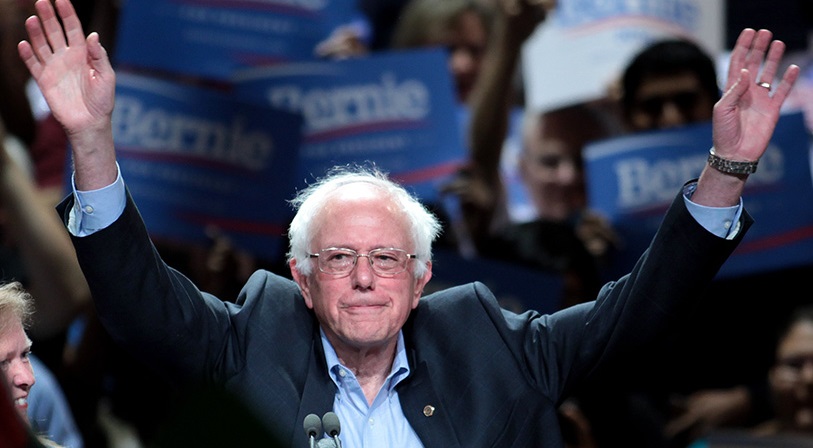This article was originally published in Spanish in Ideas de Izquierda, October 8th 2015.
The Democrats haven’t been able to contain the apathy and discontent towards a party which, apart from minor differences in rhetoric and politics, is viewed as a party of the millionaire elite that governs the country. At the same time, the Republicans struggle with their own problems, being a party with a base that is mostly white and male – an aging demographic – and which is unable to establish political influence with new social sectors that are gaining influence like women, Latinos, and Black people.
In addition to the demographic changes, the “millennial generation” has been the driving force in recent phenomena like Occupy Wall Street, movements for a $15 minimum wage, and Black Lives Matter. Although the millennials are not a homogenous group and their characteristics do not equate them with the Left, they have some common characteristics that make them feel like, in one form or another, the two traditional parties do not represent them: greater openness to social matters (homosexuality, legalization of drugs, immigration), a critical view of neoliberalism, and, most of all, the fact that they have lived a better part of their lives governed by two families: the Clintons and the Bushes.
Dynasties and Outsiders
The fact that Jeb Bush and Hillary Clinton are the most probable candidates for the 2016 election generates little enthusiasm in one of the most extensive voting blocs (even though they’re not certain how many will participate). The success of Sanders and Trump on the campaign trail raise the question of limitations within both Establishment parties; Hillary Clinton isn’t able to challenge the apathy of the Democratic voters, and Jeb Bush can’t attract the base of the Republican voters.
In part, this explains why the most attractive figures in the primary elections are two political outsiders: billionaire Donald Trump for the Republican Party and Vermont Senator Bernie Sanders for the Democratic Party. Trump is leading polls for the Republicans, even surpassing right-wing conservative favorites who were expected to do better. Sanders does not have a lead over Clinton, but has held rallies with over 10 thousand in attendance in some cities and has high ratings in swing states like Iowa and New Hampshire. Neither Trump nor Sanders are taking up the traditional platform of their respective parties and yet they are attracting the most active support of voters.
It’s unlikely that either one of them will win the primaries, but the popularity of both candidates demonstrates that there is a bipartisan crisis and both parties need to find ways to contain the wings that are moving further to the right and left. The Republicans were able to sidestep this problem when the Tea Party presented itself as a third party by containing them within the Republican Party as the ultraconservative wing. Similarly, the Democratic Party establishment welcomed Bernie Sanders’ decision to run for president. Since he’s not running as an independent, it allows the party to recover a progressive image, which was compromised in part by Barack Obama’s broken promises, but also by its inability to take a leading role in recent movements. Examples include the crisis with black youth mobilizing against racism, the Democratic Party’s weakening ties to labor, and the fact that the DP is seen as the “party of the 1%”. Ultimately, Trump and Sanders are figures that help fuel the bipartisan crisis.
Like in other elections, the discussion about the feasibility of a third party arises. Although most are far from articulating an interest in an electoral alternative today, the possibility arises based on the popular rejection of both parties (many seeing both parties as parties for the 1%). At the beginning of September, a post on a New York Times blog raised this discussion, and presents the possibility beyond of the figure of Sanders: “Again and again, third parties have pushed new ideas into the mainstream…It’s no coincidence that the newest third-party politician elected to office, the Seattle City Council member Kshama Sawant of the Socialist Alternative party, rode to victory in 2013 in part by calling for a $15 minimum wage.” Outside of any mechanical logic, it’s a valid reflection, and an open question for the left in the United States, which is going through this today with the Bernie Sanders candidacy.
The left and Bernie Sanders
For the left, the appearance of the movements mentioned above (BLM, OWS, and $15 minimum wage) mean the possibility of uniting with youth and sectors of workers for the first time in many decades, and to emerge, on a local level, as an alternative in the political terrain. The election of Kshama Sawant as a Seattle City Council member in 2013, running on the movement for a 15$ minimum wage and later creating the “$15 now” campaign, brought a breath of fresh air to the relationship between left organizations and social movements. She showed that it’s possible to be left of the Democratic Party and not be isolated. Even with the limitations of Sawant’s politics, the example shown in Seattle demonstrates that today’s “changing times” are favorable for the left. Unlike previous movements, like the anti-globalization or the anti-war movement, the recent movements are taking place within the period of declining US imperialist hegemony. They’re the children of an economic crisis of historic magnitudes, and, perhaps most importantly, they haven’t suffered any great defeats.
In this context, Sanders’ candidacy was a step back for the left, forcing it to discuss political alternatives within the boundaries of the Democratic Party. It’s true that nobody on the left exaggerates positive characteristics of Sanders’ candidacy, and many tend to outline the limitations of a candidate that is appealing because of his “fight” against corporations, but which doesn’t have a political program that goes beyond the construction of a welfare state. The question is: Does supporting Sanders’ candidacy (within the Democratic Party) create opportunities for the left to reach a wider audience and generate conditions to strengthen itself?
Organizations like Socialist Alternative, Solidarity and individuals like Bhaskar Sunkara, editor of Jacobin magazine, agree that it’s necessary to support Sanders and actively participate in the campaign. With varying motives they believe that once the primaries are over, which Hillary Clinton will surely win, all of the enthusiasm generated by the Sanders campaign can be transformed into a “political movement” that the left can influence.
Counter to this position, organizations like the ISO and Socialist Action, amongst others, argue that supporting Sanders would result in supporting the Democratic Party, and not a movement that the left could take advantage of. In the same vain, they look back on the experience of Jesse Jackson’s campaign in the democratic primaries of the 1980s. Socialist Worker argues, “Jesse Jackson’s campaigns for the Democratic presidential nomination even produced an organization–the National Rainbow Coalition–that some activists hoped might break from the Democratic Party if Jackson lost the nomination. But Jackson himself remained loyal to the party, and the Rainbow Coalition never took on a life beyond the orbit of Democratic Party politics.”
The example of Jackson’s candidacy is a great comparison, since Sanders has already declared that he would support Clinton if she wins the primaries. It is clear that the Vermont Senator’s candidacy is not intended to strengthen movements or generate new ones. In fact, the movements that already exist are being used by Sanders to strengthen his campaign. This only weakens social movements’ position and reduces them to just a figure that is there to pressure the Democratic Party. His candidacy raises the expectation that the left can best get their demands met by pressuring the Democrats.
However, even though the critics of supporting the Sander’s campaign are correct they are not putting forth ideas about how the US left can emerge as an independent political force. In general, they tend to focus their expectations on third parties, the candidates that can break the tight regime of the two-party system, without making a clear class distinction. They support third parties that do not differentiate themselves from the bourgeois parties and certainly do not have a revolutionary program and strategy.
What the majority of the left does agree on is that it would have been a better alternative if Sanders had run as an independent candidate outside of the Democratic Party. However, this would have been similar to calling to support the Green Party or candidates like Ralph Nader. In other words, supporting an “independent Sanders” is supporting a third party that doesn’t draw a clear distinction between classes, that doesn’t differentiate itself from the bourgeois parties, and that focuses on reformist policies. It gives the illusion that running as a candidate outside of the two dominant parties is enough. Perhaps, this position could have been a legitimate response from the left in the most reactionary period of neoliberalism. However by maintaining this position, despite the change in the current political climate, the left is underestimating the potential for the rise of a revolutionary left which is united with sectors of workers and youth, something which was not possible in the last 40 years.
Recent history has shown us that neither the Green Party nor Nader’s candidacy generated a lasting movement that strengthened the left’s role in politics or workers’ struggles. In fact, as we stated above, the movements that have arisen more recently are a result of the current climate and aren’t related to recent electoral phenomena.
Sawant’s campaign and her connection with the movement for an increase in the minimum wage shows that the left can build relationships with movements without the need for reformist groups acting as a middleman. This is extremely different than previous periods: the current conditions are ripe for the left (even at a small or local level) to come forward as a political alternative. Parts of the left are aware of this change. In a previous article, we reflected on the call by the conference on the Future of Left and Independent Politics: “From Kshama Sawant’s election as an open socialist on the Seattle City Council to the numerous other socialist and independent left campaigns (…) interest in a working class alternative is growing. However, in order to really begin building a viable electoral alternative, we first need to forge unity between our disparate campaigns.”
Bernie Sanders’ candidacy creates an interregnum in the debate about the possibility for the left to have politics independent of the traditional parties. This was expressed in calls such as the Socialist Alternative’s call for the construction of a “party of the 99%” and the campaign supported by almost all of the left to run 100 independent candidates throughout the country to replicate the example of Seattle. Even though the content of these independent candidates varied greatly as far as their political program, and the call was centered on “occupying spaces of power” more than empowering social movements, it was about creating a united progressive alternative, the opposite of supporting Sanders within the Democratic Party.
In some ways, this is how the international discussion about the ways that a revolutionary alternative can emerge took shape in the United States. Like in other parts of the world, the debate about how to construct a revolutionary party often ended up looking for shortcuts by forming “broad parties,” and in other cases, by fully backing reformists like Podemos in Spain or Syriza in Greece. With the recent events in Greece and the results of the ex Left Platform (today Popular Unity) in the elections, it’s possible to assess the politics of organizations that supported Syriza and those that remained independent.
Meanwhile in Argentina the positive electoral performance of the Left and Workers’ Front (FIT), along with their connection with the vanguard of the workers’ movement (especially the PTS), are beginning to be viewed by many within the left as part of this discussion. Despite differences in politics, much of the left considers the FIT and the left’s experiences in Argentina to be “a school for revolutionary strategy and tactics which deserves international study, dialogue, critique and solidarity.” (“The left gains in Argentina’s elections”). As the Green Left Weekly observed “The primaries also marked the continued rise of the Left and Workers Front (FIT). The far left ticket increased its votes from 2011 by 50% and narrowly missed out on fourth position(….)The FIT has won the respect of many due to its strong campaigning within trade unions, on universities and in parliament.” Contrary to those that look for shortcuts via reformism, the FIT holds class independence and a worker controlled government as central to their program. Maintaining this position has not been easy, but it is starting to pay off, making the FIT the 4th largest political force in Argentina. Compared to reformist parties like Syriza (whose transition from “government of the left” to “government for the third memorandum” took only 8 months) and their current challenges, the FIT represents an important experience to follow closely.
For the United States left, the stagnation that can keep them from observing political changes and leave them acting based on a logic of defensive resistance is as harmful as the temptation to take a shortcut by supporting reformist parties. The current climate is ripe with historic conditions needed to reestablish a strategic relationship with the social movements and sectors of the workers’ movement that was impossible during the “long night” of neoliberalism.












